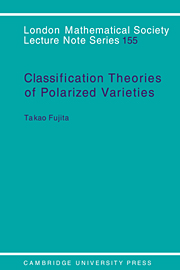Chapter III - Classification Theories of Projective Varieties
Published online by Cambridge University Press: 17 March 2010
Summary
In this chapter we are mainly concerned with the cases in which L is very ample and char(ℝ) = O. We will survey the theories due to Castelnuovo, Ionescu, Sommese, et al.
Castelnuovo bounds
For any curve C in P ≃ ℙN which is not contained in any hyperplane, Castelnuovo has found an upper bound for the genus of C in terms of the degree. Here we provide a higher dimensional version of Castelnuovo bound using the hyperplane section method.
(16.1) Given positive integers C and d, we set øC,d(µ) = (d − C − 1)µ − Cµ (µ − 1)/2 and γ(C, d) = øC,d(q) where q is the largest integer such that Cq ≤ d − 1. Then we have the following.
Fact (Castelnuovo bound). Let C be an irreducible reduced curve of degree d in ℙNsuch that h0 (C, O(1)) = N + 1. Then h1 (C, Oc) ≤ γ(N−1, d) unless C is strange.
For a proof, see [GH;p.252] and [Rat]. Here, a curve C is said to be strange if all the tangent lines at smooth points of C pass through a common point. If char(ℝ) = O, no curve is strange except lines. Even if char(ℝ) > O, smooth curves are not strange except conic curves in case char(ℝ) = 2 (cf. [Ha4;p.312]).
(16.2) Remark.
1) γ(C, µC + 1) = Cµ(µ − 1)/2 and γ(C, d) is linear in d in the interval µC + 1 ≤ d ≤ (µ + 1)C + 1.
Information
- Type
- Chapter
- Information
- Classification Theory of Polarized Varieties , pp. 139 - 163Publisher: Cambridge University PressPrint publication year: 1990
Accessibility standard: Unknown
Why this information is here
This section outlines the accessibility features of this content - including support for screen readers, full keyboard navigation and high-contrast display options. This may not be relevant for you.Accessibility Information
- 1
- Cited by
